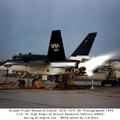
WIKIARCHIVES.SPACE
The Human Spaceflight Archive

The exhaust plume from the left engine of NASA's F-18 High Alpha Research Vehicle (HARV) is deflected upward by the paddle-like vanes of the aircraft's thrust vectoring system during an early morning "hot loads" ground test of the system at the NASA Dryden Flight Research Center, Edwards, California. The thrust vectoring system was used to enhance maneuverability and control in flight regimes where conventional controls are ineffective.
Information
- Taken in
- Edwards Air Force Base
- Author
- NASA
- Description
-
The exhaust plume from the left engine of NASA's F-18 High Alpha Research Vehicle (HARV) is deflected upward by the paddle-like vanes of the aircraft's thrust vectoring system during an early morning "hot loads" ground test of the system at the NASA Dryden Flight Research Center, Edwards, California. The thrust vectoring system was used to enhance maneuverability and control in flight regimes where conventional controls are ineffective.
During the tests Feb. 15-22 1991, the thrust vectoring vanes were tested with both engines running and individually, and validated the structural loads and thermal profiles on the three vanes surrounding each engine. The tests paved the way for later thrust vectoring aircraft.
Data from the NASA high angle of attack program is producing technical data to validate computer codes and wind tunnel research about airflow phenomena at high angles of attack and is expected to lead to better maneuverability in future high performance aircraft and make them safer.
- Created on
- Thursday 14 February 1991
- Albums
- US SPACE PROGRAM / AERONAUTICS RESEARCH / F-18 HORNET / HARV
- Source link
- https://www.dfrc.nasa.gov/Gallery/Photo/F-18HARV/index.html
- Visits
- 18
- Rating score
- no rate
- Rate this photo
- License
- Public Domain
- Modified by WikiArchives
- No (original)
- Downloads
- 0
Powered by Piwigo






